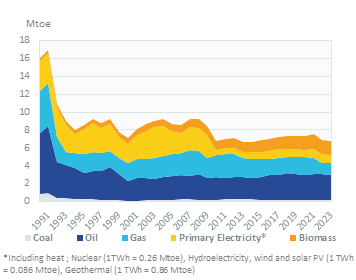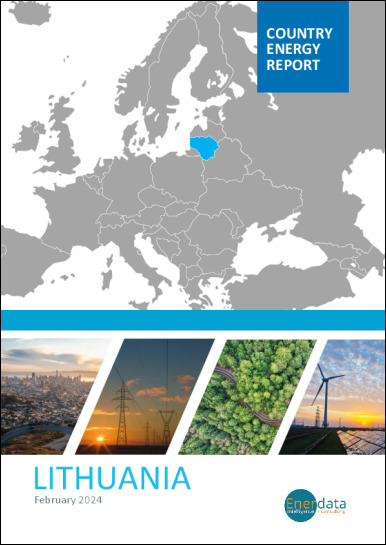- Update
-
- Format
- 3 files (PDF report, 2 Excel files)
- Pages
-
37 (Report only)
- Delivery
- Immediate by e-mail
- GENERAL OVERVIEW
- INSTITUTIONS AND ENERGY POLICY
- ENERGY COMPANIES
- ENERGY SUPPLY
- ENERGY PRICES
- ENERGY CONSUMPTION
- ISSUES AND PROSPECTS
- DATA TABLES
- ABBREVIATIONS
- GLOSSARY
Buy Lithuania energy report
Price without VAT. Depending on your statute and location, VAT might be applicable. Get in touch with us for more information.
After validation, you will immediately receive 3 files by email (one pdf report and 2 excel files containing the datasets).
Overview
This analysis includes a comprehensive Lithuania energy market report and updated datasets. It is derived from the most recent key economic indicators, supply and demand factors, oil and gas pricing trends and major energy issues and developments surrounding the energy industry. The report provides a complete picture of the country situation, dynamics, current issues and future prospects. With market data and continuous follow-up of markets news, this report brings clear and concise insights with which to tackle national energy challenges and opportunities. Browse the tabs below for a detailed table of contents, the list of graphs and tables, and details on the data files.
Highlights
- The country targets a share of 55% of renewables in final consumption in 2030 and 80% in 2050.
- Ignitis is the main energy company through stakes in various power and gas companies.
- Most of the power supply is imported; net imports represented 63% of power consumption in 2023.
- Electricity prices have doubled since 2020.
- Gas prices for households rose fivefold between 2020 and 2023.
- Total energy and electricity consumption has fallen sharply since 2021.
- Gas consumption has halved since 2010.
- Lithuania is strengthening its power and gas interconnections with Poland, Sweden, and Latvia.
- New capacities will be required to offset thermal plant decommissioning and to improve power independence.
Institutions & Energy Policy
The Ministry of Energy is responsible for the energy sector.
The Lithuanian Energy Agency is a non-profit public entity, created in 2018, to operate in the fields of energy policy, energy efficiency, and energy resources, as well as the implementation and monitoring of the national energy independence strategy and state programs; it also manages oil products reserves.
Energy Companies
Gas:
Ignitis UAB supplies more than 99% of the gas for retail.
Energy Supply
Oil:
Apart from a marginal production of around 30 kt, Lithuania imports all its crude oil (9 Mt in 2023, mainly from Saudi Arabia (40%), followed by Norway (27%) and the United States (24%). It is refined at the Mazeikiai refinery which has a capacity of 15 Mt/year, and which operates at around 2/3 of its capacity.
Energy Prices
Electricity:
Electricity prices for households almost doubled between 2021 and 2023 to 26.4€c/kWh. They are around the EU average.
For industry, electricity prices more than doubled over 2020-2022 (+50%/year) and decreased by 25% in 2023 to 14.8€c/kWh; industry prices are 25% lower than EU prices.
Graph: ELECTRICITY PRICES FOR INDUSTRY AND HOUSEHOLDS (€c/kWh)
Energy Consumption
Total energy consumption per capita is 2.4 toe and 4 000 kWh for electricity (2023); both are29% below the EU average.
Graph: CONSUMPTION TRENDS BY ENERGY SOURCE (Mtoe)

Issues & Prospects
Gas:
In 2020, NERC approved Amber Grid's ten-year gas transmission network development plan; investments are expected to reach €229m between 2020 and 2025.
In 2030, the amount of RES gas is projected to reach 1.6 TWh (8% of total natural gas demand), including 0.7 TWh from green hydrogen and 0.9 TWh from biogas.
- GRAPH 1: CO2-energy emissions (MtCO2)
- GRAPH 2: Installed electric capacity by source (2023, %)
- GRAPH 3: Gross power production by source (TWh)
- GRAPH 4: Power generation by source (2023, %)
- GRAPH 5: Gasoline & diesel prices (€/l)
- GRAPH 6: Electricity prices for industry and households (€c/kWh)
- GRAPH 7: Gas prices for industry and households (€c/kWh GCV)
- GRAPH 8: Consumption trends by energy source (Mtoe)
- GRAPH 9: Total consumption market share by energy (2023, %)
- GRAPH 10: Final consumption market share by sector (2023, %)
- GRAPH 11: Oil consumption (Mt)
- GRAPH 12: Oil consumption breakdown by sector (2023, %)
- GRAPH 13: Electricity consumption (TWh)
- GRAPH 14: Electricity consumption breakdown by sector (2023,%)
- GRAPH 15: Natural gas consumption (bcm)
- GRAPH 16: Gas consumption breakdown by sector (2023, %)
- GRAPH 17: Coal consumption (Mt)
- GRAPH 18: Coal consumption breakdown by sector (2023, %)
- Economic Indicators: Annual historical data including population, GDP growth, imports and exports, inflation rate, energy security and efficiency indicators, CO2 emissions.
- Supply Indicators: Historical data including oil and gas reserves, electric and refining capacity, energy production, power production and external trade. All are detailed by energy source.
- Demand Indicators: Historical data including consumption per inhabitant, consumption trends, total consumption by energy source, final consumption by energy source and sector, and electricity consumption by sector.
- Energy Balances: Single table displaying the overall energy industry balance per annum, also graphically displayed by energy sub-segment.
- Infrastructure Projects: Covers power plant projects by energy, technology, status and operator, gas plant projects by status and operator and LNG contracts.
The Lithuania energy market data since 1990 and up to
is included in the Excel file accompanying the Lithuania country report.
It showcases the historical evolution, allowing users to easily work with the data.
Key Data included in the excelsheet:
- Economic indicators: Annual historical economic indicators, energy security, energy efficiency and CO2 emissions.
- Supply indicators: Annual historical reserves, capacity, production and external trade (imports(+) exports(-) balance).
- Demand indicators: Annual historical consumption per capita, consumption trends, total consumption, final consumption (per energy and per sector) and electricity consumption total and per sector.
- Energy Balance: total and per energy.
- Lithuania Energy Prices: In addition to the analysis provided on the report we also provided a data set which includes historical details on the Lithuania energy prices for the follow items: price of premium gasoline (taxes incl.), price of diesel (taxes incl.), price of electricity in industry (taxes incl.), price of electricity for households (taxes incl.), price of natural gas in industry (taxes incl.), prices of natural gas for households (taxes incl.), spot price of Brent and CO2 emissions (from fuel combustion).
 Energy and Climate Databases
Energy and Climate Databases Market Analysis
Market Analysis